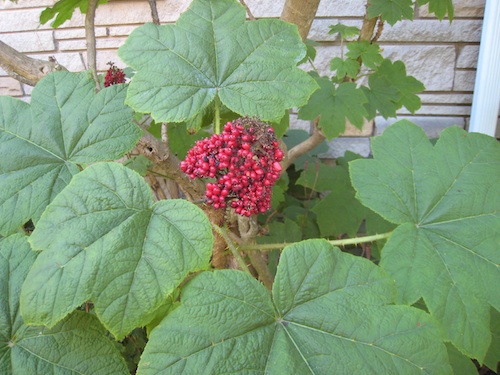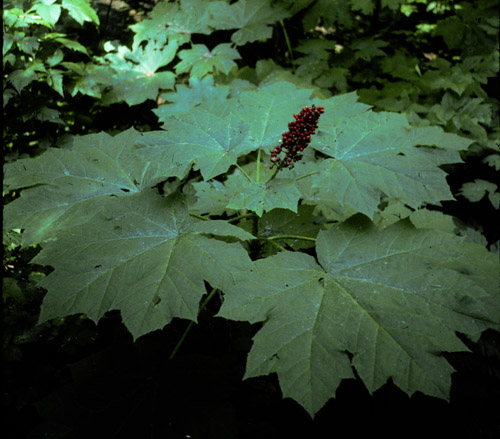Plant of the Month: August 2011
|
| Devil's Club |
| Oplopanax horridus (Sm.) Miq. |
| = Panax horridus Sm. 1813 |
| = Fatsia horrida (Sm.) Benth. & Hook. f. |
| = Echinopanax horridus (Sm.) Decne. & Planch. ex Harms |
ARALIACEÆ; Ginseng Family
|
| Devil's Club is a deciduous shrub related to the healing herb ginseng, common ivy, and Fatsia shrubs. It is an unmistakable denizen of Seattle's wet ravines. It looks tropical and thrives in drippy, mossy sites. Its native range extends from Alaska to Lake Superior, south into northern California. Two related species grow in far east Asia. On the whole, Devil's Club is uncommon in Seattle, but is nonetheless highly conspicuous and easily found in wet woods. It usually is seen 8 to 16 feet tall and forming a thicket. It grows in rich, moist, black soil, among lady ferns, nettles and the like. |
| Immense maple-like leaves, often more than 12 inches wide (I measured one 2 feet 5 inches wide), are borne atop long branches that are covered with slender sharp prickles. Hence the names Devil's Club, Devil's Canes, and Devil's Walking-Stick. The leaves lighten to yellowish and drop in fall. Due to the horribly sharp prickles, this shrub is not one to touch. Even the leaf and its stems have prickles. |
| In late April, May, or June, greenish-white flowers appear in narrow upright clusters 4 to 12 inches long; they turn into bright red, handsome berries by late summer. |
| In nature, prickles are usually an adaptation that plants eveolved to dissuade animals from eating them. Clever humans, with gloves and tools, can dig the plump roots of Devil's Club, peel them, and eat them. I have not encountered reports saying that the berries are edible or toxic. Nancy J. Turner wrote: "The berries were considered inedible by all Coastal Indian groups, possibly because they are so spiny and difficult to harvest." [p 236 of Food Plants of British Columbian Indians Part 1 Coastal Peoples 1975] Francois Couplan, in Encyclopedia of Edible Plants of North America (1998), wrote on p. 320 "The roots as well as the young, succulent shoots and stems were used as food by Indians and Inuits of Alaska." |
| Devil's Club is cultivated at the U.W. Medicinal Herb Garden, and in some private gardens, such as on the shady side of a house: a photo below shows such a one. It has been used in herbal medicine. Leslie Haskin wrote in Wild Flowers of the Pacific Coast "Next to the hellebore this was undoubtedly the Coast Indians' most valued medicine." |
In his book The Herbal Center of Healing, Gary J. Lockhart wrote (p. 232): "Doctors in British Columbia, Canada, told an Indian man that he would have to take insulin for his diabetes. They were surprised when he appeared healthy and perfectly normal without insulin. His secret was drinking a tea of the roots of devil's club Oplopanax horridus. The plant attracted medical investigators, but they were unable to isolate the active chemical and the project was dropped. Oplopanax japonicus was once used in Japan for diabetes. Neither tea cured the patient, but it eliminated the need to inject insulin."
Back
|

Devil's Club in Seattle cultivation; photo by ALJ
|

Devil's Club in the wild; photo by ALJ
|
|
|

